Qiufeng Wang
Can MLLMs Absorb Math Reasoning Abilities from LLMs as Free Lunch?
Oct 16, 2025Abstract:Math reasoning has been one crucial ability of large language models (LLMs), where significant advancements have been achieved in recent years. However, most efforts focus on LLMs by curating high-quality annotation data and intricate training (or inference) paradigms, while the math reasoning performance of multi-modal LLMs (MLLMs) remains lagging behind. Since the MLLM typically consists of an LLM and a vision block, we wonder: Can MLLMs directly absorb math reasoning abilities from off-the-shelf math LLMs without tuning? Recent model-merging approaches may offer insights into this question. However, they overlook the alignment between the MLLM and LLM, where we find that there is a large gap between their parameter spaces, resulting in lower performance. Our empirical evidence reveals two key factors behind this issue: the identification of crucial reasoning-associated layers in the model and the mitigation of the gaps in parameter space. Based on the empirical insights, we propose IP-Merging that first identifies the reasoning-associated parameters in both MLLM and Math LLM, then projects them into the subspace of MLLM, aiming to maintain the alignment, and finally merges parameters in this subspace. IP-Merging is a tuning-free approach since parameters are directly adjusted. Extensive experiments demonstrate that our IP-Merging method can enhance the math reasoning ability of MLLMs directly from Math LLMs without compromising their other capabilities.
Towards Understanding Feature Learning in Parameter Transfer
Sep 26, 2025Abstract:Parameter transfer is a central paradigm in transfer learning, enabling knowledge reuse across tasks and domains by sharing model parameters between upstream and downstream models. However, when only a subset of parameters from the upstream model is transferred to the downstream model, there remains a lack of theoretical understanding of the conditions under which such partial parameter reuse is beneficial and of the factors that govern its effectiveness. To address this gap, we analyze a setting in which both the upstream and downstream models are ReLU convolutional neural networks (CNNs). Within this theoretical framework, we characterize how the inherited parameters act as carriers of universal knowledge and identify key factors that amplify their beneficial impact on the target task. Furthermore, our analysis provides insight into why, in certain cases, transferring parameters can lead to lower test accuracy on the target task than training a new model from scratch. Numerical experiments and real-world data experiments are conducted to empirically validate our theoretical findings.
The Demon is in Ambiguity: Revisiting Situation Recognition with Single Positive Multi-Label Learning
Aug 29, 2025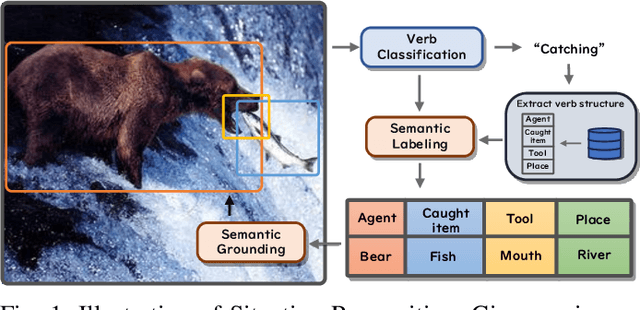
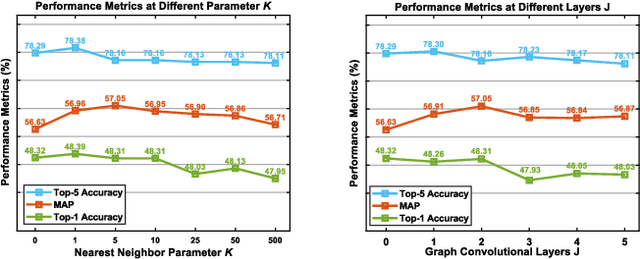
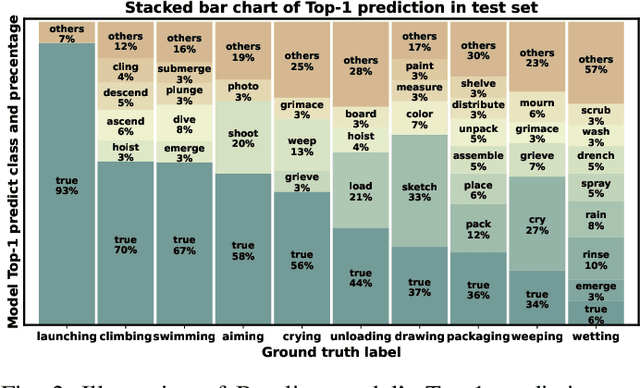
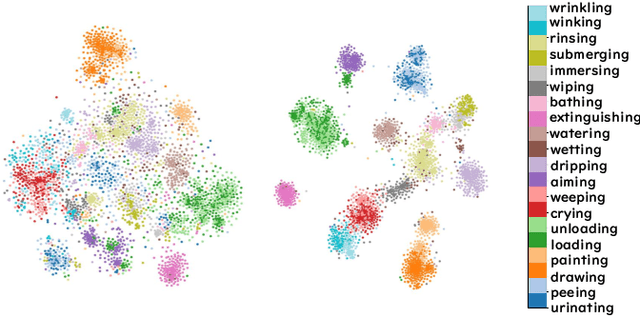
Abstract:Context recognition (SR) is a fundamental task in computer vision that aims to extract structured semantic summaries from images by identifying key events and their associated entities. Specifically, given an input image, the model must first classify the main visual events (verb classification), then identify the participating entities and their semantic roles (semantic role labeling), and finally localize these entities in the image (semantic role localization). Existing methods treat verb classification as a single-label problem, but we show through a comprehensive analysis that this formulation fails to address the inherent ambiguity in visual event recognition, as multiple verb categories may reasonably describe the same image. This paper makes three key contributions: First, we reveal through empirical analysis that verb classification is inherently a multi-label problem due to the ubiquitous semantic overlap between verb categories. Second, given the impracticality of fully annotating large-scale datasets with multiple labels, we propose to reformulate verb classification as a single positive multi-label learning (SPMLL) problem - a novel perspective in SR research. Third, we design a comprehensive multi-label evaluation benchmark for SR that is carefully designed to fairly evaluate model performance in a multi-label setting. To address the challenges of SPMLL, we futher develop the Graph Enhanced Verb Multilayer Perceptron (GE-VerbMLP), which combines graph neural networks to capture label correlations and adversarial training to optimize decision boundaries. Extensive experiments on real-world datasets show that our approach achieves more than 3\% MAP improvement while remaining competitive on traditional top-1 and top-5 accuracy metrics.
Exploiting Layer Normalization Fine-tuning in Visual Transformer Foundation Models for Classification
Aug 11, 2025Abstract:LayerNorm is pivotal in Vision Transformers (ViTs), yet its fine-tuning dynamics under data scarcity and domain shifts remain underexplored. This paper shows that shifts in LayerNorm parameters after fine-tuning (LayerNorm shifts) are indicative of the transitions between source and target domains; its efficacy is contingent upon the degree to which the target training samples accurately represent the target domain, as quantified by our proposed Fine-tuning Shift Ratio ($FSR$). Building on this, we propose a simple yet effective rescaling mechanism using a scalar $\lambda$ that is negatively correlated to $FSR$ to align learned LayerNorm shifts with those ideal shifts achieved under fully representative data, combined with a cyclic framework that further enhances the LayerNorm fine-tuning. Extensive experiments across natural and pathological images, in both in-distribution (ID) and out-of-distribution (OOD) settings, and various target training sample regimes validate our framework. Notably, OOD tasks tend to yield lower $FSR$ and higher $\lambda$ in comparison to ID cases, especially with scarce data, indicating under-represented target training samples. Moreover, ViTFs fine-tuned on pathological data behave more like ID settings, favoring conservative LayerNorm updates. Our findings illuminate the underexplored dynamics of LayerNorm in transfer learning and provide practical strategies for LayerNorm fine-tuning.
GeoSDF: Plane Geometry Diagram Synthesis via Signed Distance Field
Jun 16, 2025Abstract:Plane Geometry Diagram Synthesis has been a crucial task in computer graphics, with applications ranging from educational tools to AI-driven mathematical reasoning. Traditionally, we rely on computer tools (e.g., Matplotlib and GeoGebra) to manually generate precise diagrams, but it usually requires huge, complicated calculations cost. Recently, researchers start to work on learning-based methods (e.g., Stable Diffusion and GPT4) to automatically generate diagrams, saving operational cost but usually suffering from limited realism and insufficient accuracy. In this paper, we propose a novel framework GeoSDF to automatically generate diagrams efficiently and accurately with Signed Distance Field (SDF). Specifically, we first represent geometric elements in the SDF, then construct a series of constraint functions to represent geometric relationships, next we optimize such constraint functions to get an optimized field of both elements and constraints, finally by rendering the optimized field, we can obtain the synthesized diagram. In our GeoSDF, we define a symbolic language to easily represent geometric elements and those constraints, and our synthesized geometry diagrams can be self-verified in the SDF, ensuring both mathematical accuracy and visual plausibility. In experiments, our GeoSDF synthesized both normal high-school level and IMO-level geometry diagrams. Through both qualitative and quantitative analysis, we can see that synthesized diagrams are realistic and accurate, and our synthesizing process is simple and efficient. Furthermore, we obtain a very high accuracy of solving geometry problems (over 95\% while the current SOTA accuracy is around 75%) by leveraging our self-verification property. All of these demonstrate the advantage of GeoSDF, paving the way for more sophisticated, accurate, and flexible generation of geometric diagrams for a wide array of applications.
Farseer: A Refined Scaling Law in Large Language Models
Jun 12, 2025
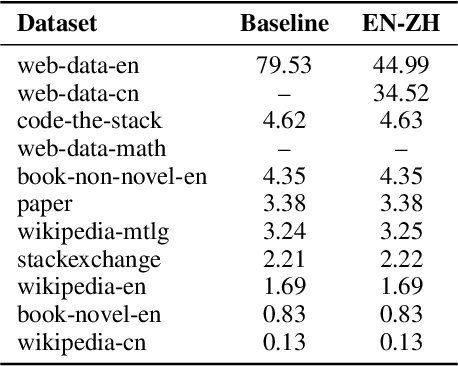
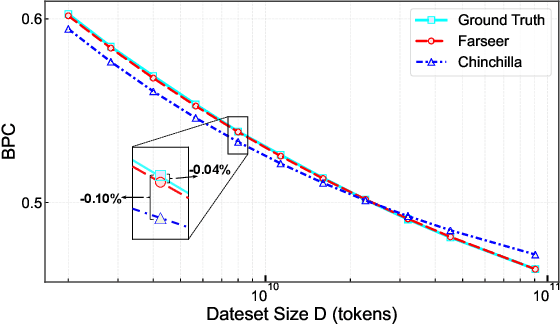

Abstract:Training Large Language Models (LLMs) is prohibitively expensive, creating a critical scaling gap where insights from small-scale experiments often fail to transfer to resource-intensive production systems, thereby hindering efficient innovation. To bridge this, we introduce Farseer, a novel and refined scaling law offering enhanced predictive accuracy across scales. By systematically constructing a model loss surface $L(N,D)$, Farseer achieves a significantly better fit to empirical data than prior laws (e.g., Chinchilla's law). Our methodology yields accurate, robust, and highly generalizable predictions, demonstrating excellent extrapolation capabilities, improving upon Chinchilla's law by reducing extrapolation error by 433\%. This allows for the reliable evaluation of competing training strategies across all $(N,D)$ settings, enabling conclusions from small-scale ablation studies to be confidently extrapolated to predict large-scale performance. Furthermore, Farseer provides new insights into optimal compute allocation, better reflecting the nuanced demands of modern LLM training. To validate our approach, we trained an extensive suite of approximately 1,000 LLMs across diverse scales and configurations, consuming roughly 3 million NVIDIA H100 GPU hours. We are comprehensively open-sourcing all models, data, results, and logs at https://github.com/Farseer-Scaling-Law/Farseer to foster further research.
HiGarment: Cross-modal Harmony Based Diffusion Model for Flat Sketch to Realistic Garment Image
May 29, 2025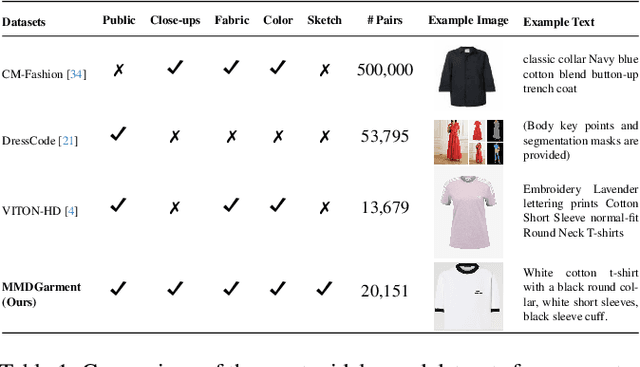

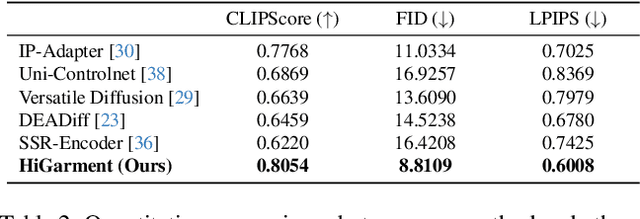

Abstract:Diffusion-based garment synthesis tasks primarily focus on the design phase in the fashion domain, while the garment production process remains largely underexplored. To bridge this gap, we introduce a new task: Flat Sketch to Realistic Garment Image (FS2RG), which generates realistic garment images by integrating flat sketches and textual guidance. FS2RG presents two key challenges: 1) fabric characteristics are solely guided by textual prompts, providing insufficient visual supervision for diffusion-based models, which limits their ability to capture fine-grained fabric details; 2) flat sketches and textual guidance may provide conflicting information, requiring the model to selectively preserve or modify garment attributes while maintaining structural coherence. To tackle this task, we propose HiGarment, a novel framework that comprises two core components: i) a multi-modal semantic enhancement mechanism that enhances fabric representation across textual and visual modalities, and ii) a harmonized cross-attention mechanism that dynamically balances information from flat sketches and text prompts, allowing controllable synthesis by generating either sketch-aligned (image-biased) or text-guided (text-biased) outputs. Furthermore, we collect Multi-modal Detailed Garment, the largest open-source dataset for garment generation. Experimental results and user studies demonstrate the effectiveness of HiGarment in garment synthesis. The code and dataset will be released.
DvD: Unleashing a Generative Paradigm for Document Dewarping via Coordinates-based Diffusion Model
May 28, 2025Abstract:Document dewarping aims to rectify deformations in photographic document images, thus improving text readability, which has attracted much attention and made great progress, but it is still challenging to preserve document structures. Given recent advances in diffusion models, it is natural for us to consider their potential applicability to document dewarping. However, it is far from straightforward to adopt diffusion models in document dewarping due to their unfaithful control on highly complex document images (e.g., 2000$\times$3000 resolution). In this paper, we propose DvD, the first generative model to tackle document \textbf{D}ewarping \textbf{v}ia a \textbf{D}iffusion framework. To be specific, DvD introduces a coordinate-level denoising instead of typical pixel-level denoising, generating a mapping for deformation rectification. In addition, we further propose a time-variant condition refinement mechanism to enhance the preservation of document structures. In experiments, we find that current document dewarping benchmarks can not evaluate dewarping models comprehensively. To this end, we present AnyPhotoDoc6300, a rigorously designed large-scale document dewarping benchmark comprising 6,300 real image pairs across three distinct domains, enabling fine-grained evaluation of dewarping models. Comprehensive experiments demonstrate that our proposed DvD can achieve state-of-the-art performance with acceptable computational efficiency on multiple metrics across various benchmarks including DocUNet, DIR300, and AnyPhotoDoc6300. The new benchmark and code will be publicly available.
Towards Cross-modal Retrieval in Chinese Cultural Heritage Documents: Dataset and Solution
May 16, 2025Abstract:China has a long and rich history, encompassing a vast cultural heritage that includes diverse multimodal information, such as silk patterns, Dunhuang murals, and their associated historical narratives. Cross-modal retrieval plays a pivotal role in understanding and interpreting Chinese cultural heritage by bridging visual and textual modalities to enable accurate text-to-image and image-to-text retrieval. However, despite the growing interest in multimodal research, there is a lack of specialized datasets dedicated to Chinese cultural heritage, limiting the development and evaluation of cross-modal learning models in this domain. To address this gap, we propose a multimodal dataset named CulTi, which contains 5,726 image-text pairs extracted from two series of professional documents, respectively related to ancient Chinese silk and Dunhuang murals. Compared to existing general-domain multimodal datasets, CulTi presents a challenge for cross-modal retrieval: the difficulty of local alignment between intricate decorative motifs and specialized textual descriptions. To address this challenge, we propose LACLIP, a training-free local alignment strategy built upon a fine-tuned Chinese-CLIP. LACLIP enhances the alignment of global textual descriptions with local visual regions by computing weighted similarity scores during inference. Experimental results on CulTi demonstrate that LACLIP significantly outperforms existing models in cross-modal retrieval, particularly in handling fine-grained semantic associations within Chinese cultural heritage.
Is Compression Really Linear with Code Intelligence?
May 16, 2025Abstract:Understanding the relationship between data compression and the capabilities of Large Language Models (LLMs) is crucial, especially in specialized domains like code intelligence. Prior work posited a linear relationship between compression and general intelligence. However, it overlooked the multifaceted nature of code that encompasses diverse programming languages and tasks, and struggled with fair evaluation of modern Code LLMs. We address this by evaluating a diverse array of open-source Code LLMs on comprehensive multi-language, multi-task code benchmarks. To address the challenge of efficient and fair evaluation of pre-trained LLMs' code intelligence, we introduce \textit{Format Annealing}, a lightweight, transparent training methodology designed to assess the intrinsic capabilities of these pre-trained models equitably. Compression efficacy, measured as bits-per-character (BPC), is determined using a novel, large-scale, and previously unseen code validation set derived from GitHub. Our empirical results reveal a fundamental logarithmic relationship between measured code intelligence and BPC. This finding refines prior hypotheses of linearity, which we suggest are likely observations of the logarithmic curve's tail under specific, limited conditions. Our work provides a more nuanced understanding of compression's role in developing code intelligence and contributes a robust evaluation framework in the code domain.
 Add to Chrome
Add to Chrome Add to Firefox
Add to Firefox Add to Edge
Add to Edge